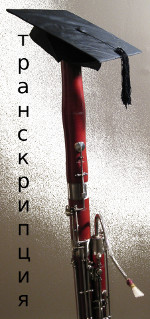Weissenborn Opus 8/2, Study #10 for advanced bassoon students. Performing dotted eight and 16th note patterns. Further discussion of healthy practice methods. By Terry B. Ewell, Bassoon Digital Professor. BDP#118. Translated by Elena Iakovleva. www.2reed.net.
Вайсенборн опус 8/2, этюд №10 для продвинутых студентов фаготистов. Исполнение ритмического строение: восьмая нота с точкой и шестнадцатая нота. Дополнительное обсуждение методов здоровой практики.Терри Б. Юэлл, Цифровой Профессор Фагота. BDP # 118. Перевод, Елена Яковлева. www.2reed.net/Russian.
TUTORIAL РУКОВОДСТВО
1. The tenth study by Weissenborn presents two specific challenges due to the dotted eighth and sixteenth notes. Many students perform the rhythm similar to a triplet rather than the correct sixteenth.
1. Десятый этюд Вайсенборна представляет две конкретные проблемы из-за восьмой с точкой и шестнадцатой. Многие ученики играют этот ритм, более похожий на триоль, чем на тот который написан.
2. I recognize that historically these might have been performed as triplets. See my article “In Search of the Borrowed Triplet Upbeat,” The Double Reed 31/3 (2008): 95-102. However, for this study we will perform the rhythm as dotted eighths and sixteenths. Here is the example incorrectly performed as triplets:
2. Я признаю, что исторически это могло быть исполнено как триоль. Прочитайте мою статью «В поисках заемной триоли», в журнале «Двойная трость» 31/3 (2008): 95-102. Однако для этого этюда мы будем исполнять ритм как восьмая с точкой и шестнадцатая. Вот пример, неправильно исполнения, как триоль:

Example (line 1) played with triplets
3. If you err on the side of notes shorter than a sixteenth that is better than longer value notes. Study #36 presents similar rhythmic issues. Here is the example correctly performed with sixteenths:
3. Если ваша ошибка заключается в том сто вы укорачеваете шестнадцатую ноту, это лучше, чем если вы ее удленняете. В этюде № 36 есть похожие ритмические проблемы. Вот пример, правильно исполнения этих шестнадцатых нот:
Example with sixteenths
4. The second issue is that this rhythm often causes students to pulse or accent the longer notes, the dotted eighth note. Thus the shorter notes are less audible and in addition the smooth melodic line is interrupted.
4. Второй вопрос заключается в том, что этот ритм часто заставляет учеников пульсировать или акцентировать более длинные ноты, восьмые с точкой. Таким образом, более короткие ноты не слышны и, кроме того, прерывается гладкая мелодическая линия.
Example poorly played
Example played correctly
5. There are two regions in the study that students often change the tempo. The second measure of the second line is often rushed. Also carefully work with the metronome in the passages with the sixteenth-note triplets in the last two lines.
5. В этом этюде есть два места где ученики часто изменяют темп. Во-втором такте второй строчки обычно торопятся. Кроме того тщательно по работайте с метрономом над пассажем триолей в последних двух строчках.

6. I try to phrase in four bar units in the first section. In the middle section up to the fourth line I use two bar phrases.
6. Я пытаюсь фразеровать по четыре такта в первом разделе. В средней части до четвертой строчки я фразерую по два такта.
Line 1, phrasing

Line 4, two measure phrases

REFLECTION Размышление
7.“Some simple techniques can decrease excessive pressure on wind instrumentalists’ hands and fingers.” (William J. Dawson, Fit as a Fiddle, p. 43).
7. «Некоторые простые методы могут уменьшить чрезмерное давление на руки и пальцы духовиков» (Уильям Доусон, «Здоров как скрипка », стр. 43).
8. I remember as a student and a young professional my reluctance to use a neck strap in addition to the seat strap support. I viewed it as a sign of weakness. An injury one day to my left shoulder, however, required me to use regularly another support for the bassoon. Immediately I notice not only relief to my left shoulder, but also less weight on my left hand. I could move my left fingerings better as well! After that time I never went back to only using the seat strap.
8. Я помню, когда я был студентом и молодым профессионалом, мое нежелание использовать шейный ремешок в дополнение к ремешку для стула. Я рассматривал это как признак слабости. Однако, однажды травма на моем левом плече потребовала, чтобы я регулярно использовал обе поддержки для фагота. Сразу же я заметил не только облегчение левого плеча, но и меньше веса на левой руке. Я в добавок смог быстрее шевелить пальцами! После этого эпизода я всегда пользуюсь обоими ремнями.
9. Tall people with long torsos will have more weight of the bassoon on their left hands than short people. While the neck strap was an improvement for me, it did, however, put additional pressure on my neck and back muscles. More recently I have been using the body harness instead of the neck strap. The body harness is great! I encourage you to consider using a body harness with a seat strap when playing the bassoon.
9. Высокие люди с длинными торсами получают больше веса от фагота в левой руке, чем низкие люди. Хотя ремень для шеи был для меня улучшением, он, однако, оказал дополнительное давление на мои мышцы шеи и спины. Совсем недавно я по пробивал упряжь вместо ремешка на шее. Упряжь для тела оказалась великолепна! Я рекомендую вам по возможности использовать упряжь и ремешок для стула при игре на фаготе.